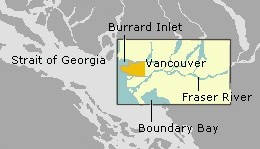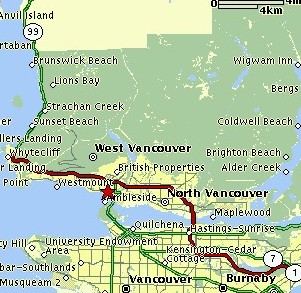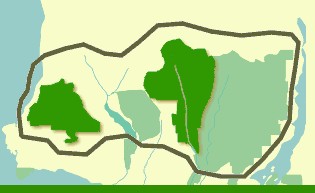
Zoomed In...

Further Zoomed In - The North Shore Mountains Area

Background Information:
Wherever one might be on the Lower Mainland of BC, the North Shore mountains are always visible and makes an imposing impression on local residents and visitors alike (Jassak, 2001). Only minutes away from Downtown Vancouver, beyond the fringe of development within two to three kilometers of the waters edge lies a huge expanse of wilderness that can be a challenge to even the most fit to explore (Jassak, 2001). Vancouver is the economic engine of the region that drives the expanding population and increasing importance of tourism to all the surrounding communities (Jassak, 2001). Between the two, the North Shore and Vancouver, they offer everyone the greatest range of recreational opportunities to be found, within proximity to a urban environment, in the world (Jassak, 2001). The mountains formed over 90 million years ago as an enormous granite batholith (Woods, 2001). This rock was bent, squeezed, fractured and uplifted to form the north-south pattern of rivers, valleys and fjords you see today (Woods, 2001).
Below images shows the North Shore mountains are the southernmost extension of BC's Coast Mountains:

Zoomed In...

Further Zoomed In - The North Shore Mountains Area

Image Sources: Yahoo Canada, Westcoast Nature.
According to Statistics Canada, the North Shore Mountains region is located within metropolitan Vancouver (Statistics Canada, 1999). Back in 1991, Vancouver's metropolitan census population is 1,268,183 (Stanford, 1992) - and in 2000 the metropolitan population reached 2,048,800 (Statistics Canada, 2001). Therefore, the population of Vancouver's metropolitan has increased a staggering 62.5% in under 20 years!! This in turn, translates to over 3% per year - which is comparable to some third world countries that display the fastest growing populations of the world today (Weeks, 1999). It is predicted that nearly 1 million more people will live within the metropolitan area over the next few decades forcing people to move into more rural settings such as the North Shore Mountains (Baxter and Ramlo, 2001). Any policy regarding the urban development of the region will have an impact (a cost) on the environment to meet the demands of the fast growing population (Molles, 1999). It is therefore very important but challenging, to incorporate this high growth rate into effective landuse planning strategies in order to establish a sustainable Vancouver population for the future generations to come (Molles, 1999).
Project Goals:
The primary objectives of this project are:
1) to determine areas of possible locations for urban development in the North Shore Mountains region due to the fast growing population concerning the Census Metropolitan Area of Vancouver
2) to address and to educate the public about the "inevitable" potential for Geographic Information Science (GIS) technology to solve/spatially analyze typical urban/environmental planning problems.
It would be simple to assume that all open and undeveloped areas in the North Shore Mountains could be considered for Urban development. However factors such as distance to water bodies, distance to water watersheds, distance to parks/forests, slope and elevation will substantially reduce the area that can still be developed. With these factors taken into consideration, this project will provide possible new locations of urban development to meet the demands for the growing population of North Shore Mountains area.
Two spatial analyses have been conducted to meet the projects objective:
1
- a Boolean Multi-Criteria Evaluation - to distinguish non-developable/developable
areas of the North Shore Mountains
2-
a Non-boolean Weighted Linear Combination - to find the areas of best suitability
of Urban development that meets enviromentail/zoning regulations.
Eventually, this project aims to address the question of "Where the
possible optimal/suitable sites for urban development in the North Shore
Mountains are located."
Please click here
for Methodology
Or click here to go back to main menu